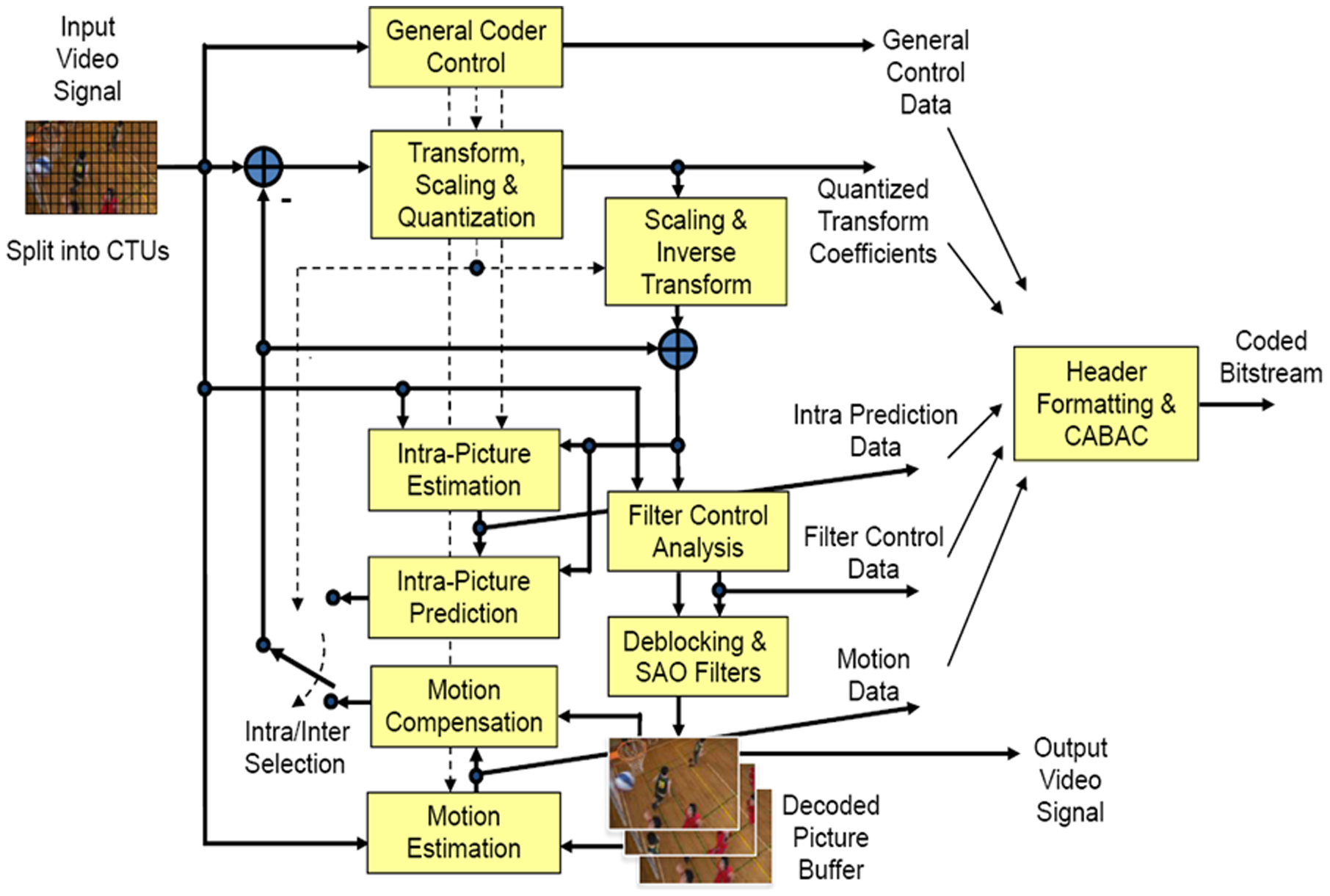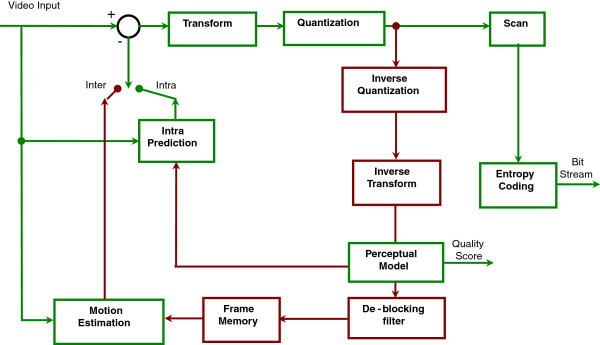|
HEVC
High Efficiency Video Coding (HEVC), also known as H.265 and MPEG-H Part 2, is a video compression standard designed as part of the MPEG-H project as a successor to the widely used Advanced Video Coding (AVC, H.264, or MPEG-4 Part 10). In comparison to AVC, HEVC offers from 25% to 50% better data compression at the same level of video quality, or substantially improved video quality at the same bit rate. It supports resolutions up to 8192×4320, including 8K UHD, and unlike the primarily 8-bit AVC, HEVC's higher fidelity Main 10 profile has been incorporated into nearly all supporting hardware. While AVC uses the integer discrete cosine transform (DCT) with 4×4 and 8×8 block sizes, HEVC uses both integer DCT and discrete sine transform (DST) with varied block sizes between 4×4 and 32×32. The High Efficiency Image Format (HEIF) is based on HEVC. Concept In most ways, HEVC is an extension of the concepts in H.264/MPEG-4 AVC. Both work by comparing different parts of ... [...More Info...] [...Related Items...] OR: [Wikipedia] [Google] [Baidu] |
Ultra-high-definition Television
Ultra-high-definition television (also known as Ultra HD television, Ultra HD, UHDTV, UHD and Super Hi-Vision) today includes 4K resolution#Resolutions, 4K UHD and 8K resolution#Resolutions, 8K UHD, which are two digital video formats with an Aspect ratio (image), aspect ratio of 16:9. These were first proposed by NHK Science & Technology Research Laboratories and later defined and approved by the International Telecommunication Union (ITU). The Consumer Electronics Association announced on October 17, 2012, that "Ultra High Definition", or "Ultra HD", would be used for displays that have an display aspect ratio, aspect ratio of 16:9 or wider and at least one digital input capable of carrying and presenting native video at a minimum resolution of . In 2015, the Ultra HD Forum was created to bring together the end-to-end video production ecosystem to ensure interoperability and produce industry guidelines so that adoption of ultra-high-definition television could accelerate. Fr ... [...More Info...] [...Related Items...] OR: [Wikipedia] [Google] [Baidu] |
High Efficiency Image File Format
High Efficiency Image File Format (HEIF) is a digital container format for storing individual digital images and image sequences. The standard covers multimedia files that can also include other media streams, such as timed text, audio and video. HEIF can store images encoded with multiple coding formats, for example both SDR and HDR images. HEVC is an image and video encoding format and the default image codec used with HEIF. HEIF files containing HEVC-encoded images are also known as HEIC files. Such files require less storage space than the equivalent quality JPEG. HEIF files are a special case of the ISO Base Media File Format ( ISOBMFF, ISO/IEC 14496-12), first defined in 2001 as a shared part of MP4 and JPEG 2000. Introduced in 2015, it was developed by the Moving Picture Experts Group (MPEG) and is defined as Part 12 within the MPEG-H media suite (ISO/IEC 23008-12). History The requirements and main use cases of HEIF were defined in 2013. The technical developm ... [...More Info...] [...Related Items...] OR: [Wikipedia] [Google] [Baidu] |
MPEG LA
MPEG LA was an American company based in Denver, Colorado that licensed patent pools covering essential patents required for use of the MPEG-2, MPEG-4, IEEE 1394, VC-1, ATSC, MVC, MPEG-2 Systems, AVC/H.264 and HEVC standards. Via Licensing Corp acquired MPEG LA in April 2023 and formed a new patent pool administration company called Via Licensing Alliance. History MPEG LA started operations in July 1997 immediately after receiving a Department of Justice Business Review Letter. During formation of the MPEG-2 standard, a working group of companies that participated in the formation of the MPEG-2 standard recognized that the biggest challenge to adoption was efficient access to essential patents owned by many patent owners. That ultimately led to a group of various MPEG-2 patent owners to form MPEG LA, which in turn created the first modern-day patent pool as a solution. The majority of patents underlying MPEG-2 technology were owned by three companies: Sony (311 patents) ... [...More Info...] [...Related Items...] OR: [Wikipedia] [Google] [Baidu] |
MPEG-H
MPEG-H is a group of international standards under development by the ISO/ IEC Moving Picture Experts Group (MPEG). It has various "parts" – each of which can be considered a separate standard. These include a media transport protocol standard, a video compression standard, an audio compression standard, a digital file format container standard, three reference software packages, three conformance testing standards, and related technologies and technical reports. The group of standards is formally known as ISO/IEC 23008 – ''High efficiency coding and media delivery in heterogeneous environments''. Development of the standards began around 2010, and the first fully approved standard in the group was published in 2013. Most of the standards in the group have been revised or amended several times to add additional extended features since their first edition. MPEG-H consists of the following parts: * Part 1: '' MPEG Media Transport'' (MMT) – a media streaming format similar t ... [...More Info...] [...Related Items...] OR: [Wikipedia] [Google] [Baidu] |
Video Coding Format
A video coding format (or sometimes video compression format) is a content representation format of digital video content, such as in a data file or bitstream. It typically uses a standardized video compression algorithm, most commonly based on discrete cosine transform (DCT) coding and motion compensation. A computer software or hardware component that compresses or decompresses a specific video coding format is a video codec. Some video coding formats are documented by a detailed technical specification document known as a video coding specification. Some such specifications are written and approved by standardization organizations as technical standards, and are thus known as a video coding standard. There are ''de facto'' standards and formal standards. Video content encoded using a particular video coding format is normally bundled with an audio stream (encoded using an audio coding format) inside a multimedia container format such as AVI, MP4, FLV, RealMedia, or M ... [...More Info...] [...Related Items...] OR: [Wikipedia] [Google] [Baidu] |
Discrete Cosine Transform
A discrete cosine transform (DCT) expresses a finite sequence of data points in terms of a sum of cosine functions oscillating at different frequency, frequencies. The DCT, first proposed by Nasir Ahmed (engineer), Nasir Ahmed in 1972, is a widely used transformation technique in signal processing and data compression. It is used in most digital media, including digital images (such as JPEG and HEIF), digital video (such as MPEG and ), digital audio (such as Dolby Digital, MP3 and Advanced Audio Coding, AAC), digital television (such as SDTV, HDTV and Video on demand, VOD), digital radio (such as AAC+ and DAB+), and speech coding (such as AAC-LD, Siren (codec), Siren and Opus (audio format), Opus). DCTs are also important to numerous other applications in science and engineering, such as digital signal processing, telecommunication devices, reducing network bandwidth usage, and spectral methods for the numerical solution of partial differential equations. A DCT is a List of Fourier ... [...More Info...] [...Related Items...] OR: [Wikipedia] [Google] [Baidu] |
Video Coding Experts Group
The Video Coding Experts Group or Visual Coding Experts Group (VCEG, also known as Question 6) is a working group of the ITU Telecommunication Standardization Sector (ITU-T) concerned with standards for compression coding of video, images, audio signals, biomedical waveforms, and other signals. It is responsible for standardization of the "H.26x" line of video coding standards, the "T.8xx" line of image coding standards, and related technologies. Administratively, VCEG is the informal name of Question 6 (Visual, audio and signal coding) of Working Party 3 (Audiovisual technologies and intelligent immersive applications) of ITU-T Study Group 16 (Multimedia and related digital technologies). Its abbreviated title is ITU-T Q.6/SG16, or more simply, ITU-T Q6/16. The goal of VCEG is to produce ITU-T Recommendations (international standards) for video coding and image coding methods appropriate for conversational (e.g. videoconferencing and video telephony) and non-conversational (e ... [...More Info...] [...Related Items...] OR: [Wikipedia] [Google] [Baidu] |
Video Compression
In information theory, data compression, source coding, or bit-rate reduction is the process of encoding information using fewer bits than the original representation. Any particular compression is either lossy or lossless. Lossless compression reduces bits by identifying and eliminating Redundancy (information theory), statistical redundancy. No information is lost in lossless compression. Lossy compression reduces bits by removing unnecessary or less important information. Typically, a device that performs data compression is referred to as an encoder, and one that performs the reversal of the process (decompression) as a decoder. The process of reducing the size of a data file is often referred to as data compression. In the context of data transmission, it is called source coding: encoding is done at the source of the data before it is stored or transmitted. Source coding should not be confused with channel coding, for error detection and correction or line coding, the means ... [...More Info...] [...Related Items...] OR: [Wikipedia] [Google] [Baidu] |
Data Compression
In information theory, data compression, source coding, or bit-rate reduction is the process of encoding information using fewer bits than the original representation. Any particular compression is either lossy or lossless. Lossless compression reduces bits by identifying and eliminating statistical redundancy. No information is lost in lossless compression. Lossy compression reduces bits by removing unnecessary or less important information. Typically, a device that performs data compression is referred to as an encoder, and one that performs the reversal of the process (decompression) as a decoder. The process of reducing the size of a data file is often referred to as data compression. In the context of data transmission, it is called source coding: encoding is done at the source of the data before it is stored or transmitted. Source coding should not be confused with channel coding, for error detection and correction or line coding, the means for mapping data onto a sig ... [...More Info...] [...Related Items...] OR: [Wikipedia] [Google] [Baidu] |
MPEG
The Moving Picture Experts Group (MPEG) is an alliance of working groups established jointly by International Organization for Standardization, ISO and International Electrotechnical Commission, IEC that sets standards for media coding, including compression coding of audio compression (data), audio, video compression, video, graphics, and Compression of Genomic Sequencing Data, genomic data; and transmission and Container format (digital), file formats for various applications.John Watkinson, ''The MPEG Handbook'', p. 1 Together with Joint Photographic Experts Group, JPEG, MPEG is organized under ISO/IEC JTC 1/ISO/IEC JTC 1/SC 29, SC 29 – ''Coding of audio, picture, multimedia and hypermedia information'' (ISO/IEC Joint Technical Committee 1, Subcommittee 29). MPEG formats are used in various multimedia systems. The most well known older MPEG media formats typically use MPEG-1, MPEG-2, and MPEG-4 AVC media coding and MPEG-2 systems MPEG transport stream, transport streams an ... [...More Info...] [...Related Items...] OR: [Wikipedia] [Google] [Baidu] |
Advanced Video Coding
Advanced Video Coding (AVC), also referred to as H.264 or MPEG-4 Part 10, is a video compression standard based on block-oriented, motion-compensated coding. It is by far the most commonly used format for the recording, compression, and distribution of video content, used by 84–86% of video industry developers . It supports a maximum resolution of 8K UHD. The intent of the H.264/AVC project was to create a standard capable of providing good video quality at substantially lower bit rates than previous standards (i.e., half or less the bit rate of MPEG-2, H.263, or MPEG-4 Part 2), without increasing the complexity of design so much that it would be impractical or excessively expensive to implement. This was achieved with features such as a reduced-complexity integer discrete cosine transform (integer DCT), variable block-size segmentation, and multi-picture inter-picture prediction. An additional goal was to provide enough flexibility to allow the standard to be applied ... [...More Info...] [...Related Items...] OR: [Wikipedia] [Google] [Baidu] |




